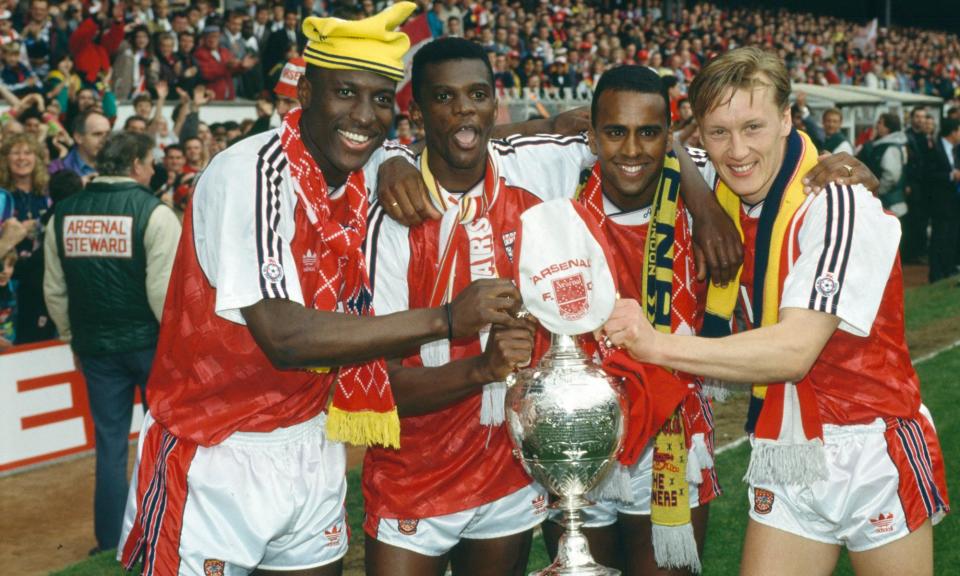Kevin Campbell, legend of the early Premier League, mixed goals with versatility

A throw-in from Lee Dixon. Alan Smith controls it at the top corner of the box and plays the ball back out to Dixon as Kevin Campbell, coming from wide, runs past him, drawing the Paris Saint-Germain midfielder Paul Le Guen with him. The movement creates space for Dixon, who has time to measure his cross. Campbell continues his run far enough for Le Guen to stop, but not quite far enough for Alain Roche to pick him up. Dixon finds Campbell and, twisting, he guides a low header past the sprawl of Bernard Lama at the near post.
The first leg of the 1994 Cup Winners’ Cup semi-final at the Parc des Princes had finished 1-1. Campbell’s goal, after seven minutes, was the only one of the second leg. Arsenal, after what felt like an extremely characteristic performance, were through to the final, which they won – 1-0, obviously – thanks to a Smith goal against Parma, and they had their first European trophy since the Fairs Cup of 1970.
Related: Kevin Campbell, former Arsenal and Everton striker, dies aged 54
After George Graham’s side won the league for a second time, in 1990-91, they lost 4-2 on aggregate in the second round of the European Cup to Benfica. There was a sense they and other English clubs had lost their European nous during the Heysel ban. Manchester United may have won the Cup Winners’ Cup in 1990-91, but it was Arsenal’s victory in the same competition three years later that suggested a club, perhaps a culture, readjusting to the European game.
Campbell was key to that. He scored against Odense in the first round, then got two in the 7-0 away demolition of Standard Liège in the second. But it was that goal against PSG in the semi-final that stands out, not just for its importance, but because it felt so characteristic.
Initially, Campbell seemed a classic No 9. He was quick, direct and powerful, good with his back to goal, a gifted header of the ball. In one season with Arsenal’s academy, he scored 59 goals. He got a hat-trick in the FA Youth Cup final in 1988. He impressed during loan spells at Leyton Orient and Leicester without making much of an impression at Highbury, where Alan Smith tended to operate as a centre-forward with Paul Merson just off him.
Campbell’s breakthrough came in 1990-91. Arsenal lost for the first – and only – time in the league that season, 2-1 at Chelsea, at the beginning of February, a game in which Campbell came off the bench to set up a late goal for Smith. Graham started him alongside Smith for Arsenal’s next game at home to Crystal Palace, replacing Perry Groves, with Merson on the left of midfield. Campbell scored his second goal of the season to make it 4-0 just after the hour; any thought that a first defeat of the season might provoke a collapse was swiftly obliterated. Campbell went on to score a further seven league goals in the run-in as Arsenal won the title by seven points from Liverpool.
Yet there was a curious sense that Campbell wasn’t fully trusted. Ian Wright was signed the following September but Campbell remained a first choice, playing 105 league games over the next three seasons. Wright was the obvious goalscorer, which meant Campbell’s role changing to become more of a supplier. He bulked up over that period and perhaps lost a little of his pace and mobility, yet there were also games when he played wide in midfield, particularly in Europe.
He was never as prolific again for Arsenal as he had been in that final three months of 1990-91, but he did have a habit of scoring important goals – the equalisers at home to Millwall and at Derby in the League Cup in 1992-93, for instance. The goal against PSG was a classic example of how he combined the roles, playing wide and yet using his movement to operate as a de facto target man.
After that Cup Winners’ Cup success, opportunities and goals began to dry up. He left Highbury but scored only nine goals over two Premier League seasons with Nottingham Forest before rediscovering his golden touch in the second tier. Nonetheless there was widespread surprise when Walter Smith insisted Everton should sign him in March 1999 after a stint at Trabzonspor had ended in acrimony over racism and unpaid wages.
Campbell instantly proved his worth with nine goals in eight starts to haul Everton away from relegation. As after that initial burst at Arsenal, he never quite found the same consistency in front of goal again but, in six further seasons at Goodison, Campbell became a hugely popular player.
His 83 Premier League goals (he also got 24 in the top flight before 1992) make Campbell the competition’s highest-scoring English player never to have won an international cap, which seems oddly in keeping. There was little flashy or eye-catching about him and the sense was that he was never fully appreciated, that clubs kept thinking they could do better. Yet Pierre van Hooijdonk went on strike when Forest decided to sell Campbell after he had helped them to promotion and clubs kept playing him after signing his replacement.
Given the variety of positions he played in, his numbers stack up remarkably well. Fans loved him, as did those who played alongside him. He may not have won individual awards of caps, or trophies after 1994, but he was a legend of the early Premier League years.

 Yahoo Sport
Yahoo Sport 






































